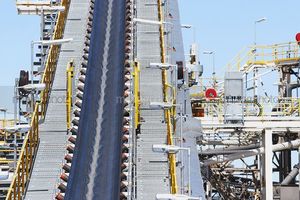Conveyor Safety Equipment
Conveyor Safety Equipment is designed to meet guarding requirements that prevent injuries from pinch points and contact with hazardous moving machine parts. These accepted products are vital to ensure employee safety and prevent injuries. The Return Roll Changer provides pinch point protection and eliminates need for high-lift equipment. Safe-Guard Belt Clamps are a patented positive tensioning system that applies even tension across the entire width of the conveyor belt. The Safe-Guard Return Idler Guard is designed to prevent injuries from pinch points and to catch the return Idlers if it should fall. The V-Return Idler Guard protects workers and equipment from falling idlers. Its durable UHMW slotted cage stops material buildup and offers easy access for maintenance. Return Idler Cage is designed to catch the return idler from falling onto unsuspecting workers or equipment, preventing injuries and down time. Flat Return Conveyor Guard is a modular guard mounted on the conveyor to guard against moving equipment.
Conveyors are one of the best productivity-enhancing tools available, but conveyor injuries in the U.S. cost employers millions of dollars annually. With the right processes and design, you can reduce these injuries and their related costs. Conveyors are generally safer than other material handling alternatives if they are maintained, designed and properly operated.As with any mechanical and electrical device, conveyors can present some safety concerns. Since they have many moving parts, anyone who works on, near, or around them should be well versed in conveyor safety and also why each rule is important and necessary.
Essential Conveyor Safety Rules
These are the bedrock essentials of operating conveyor in a safe manner.These are basic rules that no operation where conveyor is utilized should ignore. Adhering to these rules is the start (bur certainly not the end) of successful conveyor safety programs.
- Don't perform service on conveyor until motor disconnect is locked Out.
- Service conveyor with only authorized maintenance personnel.
- Keep clothing, fingers, hair, and other parts of the body away from conveyor.
- Don't climb, step, sit or ride on conveyor at any time.
- Don't load conveyor outside of the design limits.
- Don't remove or alter conveyor guards or safety divides.
- Know location and function of all stop/start controls.
- Keep all stopping/starting control devices free from obstructions.
- All personnel must be clear of conveyor before starting.
- Operate conveyor with trained personnel only.
- Keep area around conveyors clear of obstructions.
- Report all unsafe practices to your supervisor.
